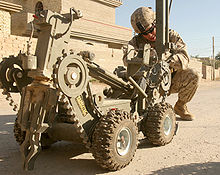- Combat engineer
-
This article is about the combatant soldier occupation. For the military science concept of shaping the physical war environment, see Military engineering.
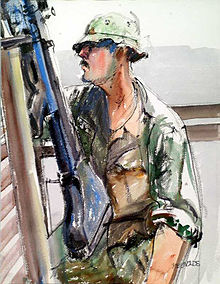 Combat Engineer by Victory V. Reynolds, Vietnam Combat Artists Program, CAT VIII, 1968. Courtesy of the U.S. Army Center for Military History.
Combat Engineer by Victory V. Reynolds, Vietnam Combat Artists Program, CAT VIII, 1968. Courtesy of the U.S. Army Center for Military History.
A combat engineer, also called pioneer or sapper in many armies, is a soldier who performs a variety of construction and demolition tasks under combat conditions. Such tasks typically include constructing and breaching trenches, tank traps and other fortifications, bunker construction, bridge and road construction or destruction, laying or clearing land mines, and other physical work in the battlefield. More generally, the combat engineer's goals involve facilitating movement and support of friendly forces while impeding that of the enemy.
Usually, a combat engineer is also trained as an infantryman, and combat engineering units often have a secondary role fighting as infantry. Beyond self-defense, combat engineers, infantry and assault troopers from armored corps units are generally the only troops that engage in the assault while dismounted. This role is limited by a lack of fire support (such as that obtained by infantry units from their mortars and recoilless rifles). However combat engineers typically do have extensive antiarmor capability in their infantry fighting role, such as with antitank missiles.
Contents
Terminology
A general combat engineer is often called a pioneer or sapper, terms derived respectively from the French and British armies. In some armies, pioneer and sapper indicate specific military ranks and levels of training.
Combat engineers who work under fire and construction engineers in service roles may be are allocated to different corps, such as the former Soviet Army, or they may be organized in the same corps. Geomatics, or surveying and cartography is another area that sometimes is integrated into military engineering corps, and in other cases is a separate responsibility, as was formerly the case in the Australian Army. While the officers of a combat engineering unit will generally be professionally-certified civil or mechanical engineers, the non-commissioned members are generally not.
- Sapper is a term that is used for soldiers in the British, Canadian, Australian, and New Zealander armies who have specialized combat engineer training.
- In the Israeli Defence Forces, Sapper 07 ( פלס 07 ) is a rank denoting a combat engineer who has graduated from basic general engineering training.
- Pioneer
- In the Finnish army, pioneeri is the private equivalent rank in the army for a soldier who has completed the basic combat engineering training. Naval engineers retain the rank matruusi but bear the pioneeri insignia on their sleeves.
- Assault pioneer
- In the British, Canadian and Australian armies, an assault pioneer is an infantry soldier with some limited combat engineer training in clearing obstacles during assaults and light engineering duties. Until recently, assault pioneers were responsible for the operation of flamethrowers.
- Field engineer
- Miner
- Pontonier
Practices and techniques
Combat engineers use practices and techniques of camouflage, reconnaissance, communication methods and enhancement of survival by other troops. Combat engineering also includes construction of roads, bridges, field fortifications, and obstacles. In these roles, combat engineers use a wide variety of hand and power tools. They are also responsible for construction rigging, the use of explosives, and carrying out demolitions, camouflage erection, field fortification construction, obstacle clearance, and obstacle construction, assault of fortifications, bridge erection, use of assault boats in water obstacle crossings, expedient road and helipad construction, general construction, route reconnaissance and road reconnaissance, and erecting communication installations.
All these role activities and technologies are divided into several areas of combat engineering:
- Mobility
Improving the ability of one's own force to move around the battlefield. Combat engineers typically support this role through reduction of enemy obstacles which include point and row minefields, anti-tank ditches, wire obstacles, concrete and metal anti-vehicle barriers and wall and door breaching in urban terrain. Mechanized combat engineer units also have armored vehicles capable of laying short bridges for limited gap-crossing.
- Clearing terrain obstacles
- Overcoming trenches and ditches
- Opening routes for armored fighting vehicles
- Constructing roads and bridges
- Countermobility
Building obstacles to prevent the enemy from moving around the battlefield. Destroying bridges, blocking roads, creating airstrips, digging trenches, etc. Can also include planting land mines and anti-handling devices when authorized and directed to do so.
When the defender must retreat it is often desirable to destroy anything that may be of use to the enemy, particularly bridges, as their destruction can slow the advance of the attackers. The retreating forces may also leave booby traps for enemy soldiers, even though these often wreak their havoc upon non-combatant civilians.
- Planting land mines
- Digging trenches and ditches
- Demolishing roads and bridges
- Explosive material handling
The placement of land mines to create minefields and their maintenance and removal.
- Clearing fields of land mines
- Demolition
- Assault
- Opening routes during assault
- Demolishing enemy structures (using bulldozers or explosive charges).
- Defense structures
Building structures which enable one's own soldiers to survive on the battlefield. Examples include trenches, bunkers, shelters, and armored vehicle fighting positions. General engineering sustains military forces in the theater through the performance of facility construction and repair, and through acquisition, maintenance, and disposal of real property.
Defensive fortifications are designed to prevent intrusion into the inner works by assault infantry. For minor defensive locations these may only consist of simple walls and ditches. The design principle is to slow down the advance of attackers to where they can be destroyed by defenders from sheltered positions. Most large fortifications are not a single structure but rather a concentric series of fortifications of increasing strength.
- Building fortifications
- Building outposts
- Building fences
- Defense against NBC weapon threats
Equipment and vehicles
Combat engineers employ a wide range of transportation vehicles and equipment, and uses weapons unique to the engineers, including those used in land mine warfare.
- Equipment
Basic combat engineering tools include safe use of: driving tools and chopping tools (hammers, mauls, sledges, screwdriver, and bits); cutting tools and smoothing tools (saws, chisels, planes, files and rasps, brush-cutting tools, miscellaneous cutting tools); drilling tools, boring tools, and countersinking tools; measuring tools, leveling tools and layout tools (rules, tapes, marking tools, levels, plumb bobs, squares); gripping tools, prying tools and twisting tools (pliers, wrenches, bars); holding tools, raising tools and grinding tools (vises, clamps, jacks, grinders, and oilstones); timber handling tools and climbing tools; digging tools (shovels, posthole diggers, picks, and mattocks); portable power tools and trailer-mounted tools (electric tool trailer and generator, portable power tools); miscellaneous tools.
- Vehicles
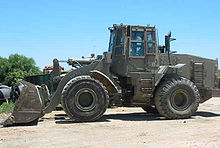 Armored front loader
Armored front loader
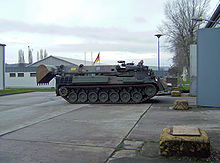 German Army combat engineer vehicle Dachs
German Army combat engineer vehicle Dachs
 This EBG combat engineering vehicle is used by the engineers of the French Army for a variety of missions
This EBG combat engineering vehicle is used by the engineers of the French Army for a variety of missions Main article: Military engineering vehicles
Main article: Military engineering vehicles- Obstacle breaching
For obstacle breaching, including minefields, the combat engineers use a variety of vehicles, explosive devices and plastic explosives including:
- Minefield breaching devices
- Dozer blade
- Mine rollers
- Bangalore torpedo
- Antipersonnel Obstacle Breaching System
- Mine-clearing line charge (MICLIC)
- Bomb disposal robots
- Explosives, mines and bombs
- Field-deployable bridges
- (ex: French EFA), Bailey bridge
Corps
Combat engineers are a key role in all armed forces of the world, and invariably found either closely integrated into the force structure, or even into the combat units of the national troops.
- Australia
- Royal Australian Engineers
- Canada
- Canadian Military Engineers
- Denmark
The Danish military engineering corps is almost entirely organized into one regiment, simply named "Ingeniørregimentet" ("The Engineering Regiment"). The core of the Danish combat engineers are the so-called armored engineers. These units usually work in separated squads, each under the command of an infantry company, and equipped with an M113. Their roles are combat demolition, minefield clearing, basic minelaying and EOR. They are also extensively trained as infantry, to support the ordinary troops in combat. Besides these units, the regiment has the different workfields of combat engineers (construction, EOD, CBRN) spread out over different companies.
- Germany
- de:Pioniertruppe (Bundeswehr)
- India
- Corps of Engineers, Indian Army
- Ireland
- Irish Army Engineer Corps
- Israel
- Israeli Engineering Corps
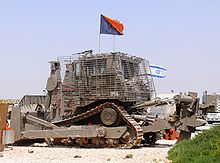 IDF Caterpillar D9 with the Combat Engineering Corps flag.
IDF Caterpillar D9 with the Combat Engineering Corps flag.
Armored bulldozers are standard combat engineering tools, as they can perform construction, destruction and EOD missions under heavy fire.In the Israeli Defence Forces the combat engineers are organized under the Combat Engineering Corps (Hebrew: חיל ההנדסה הקרבית). In addition to IEC sappers, each infantry brigade has an engineer company trained with basic engineering and EOD skills. IEC sappers are often attached to other units (such as armored divisions or infantry) in order to help them breach obstacles and handle explosive threats. The IEC operates advance engineering tools such as the IDF Caterpillar D9 armored bulldozer, IDF Puma armored CEV, Armoured vehicle-launched bridges, armored engineering vehicles, EOD robots and electromagnetic mine-detectors. Their main role is enabling Israeli forces to advance (breach the enemy's obstacles), stop the enemy's movement, handle explosives and perform construction and destruction missions under fire. The Israeli engineering corps is also responsible for counter-NBC warfare (i.e. defending troops against unconventional weapon and clean infected areas). The IEC has a special unit, called Yahalom (in Hebrew it means "Diamond" but also abbreviation of "Engineering Unit for Special Operations") which handles EOD, commando, engineering recon, advance robotics, tunnel warfare, maritime breaching, counter-NBC, and other classified tasks.
The Israeli combat engineer Corps motto is "Rishonim Tamid" Hebrew: ראשונים תמיד, meaning "Always first".
- New Zealand
- Corps of Royal New Zealand Engineers
- Pakistan
- Pakistan Army Corps of Engineers
- Military Engineering Service
- Russia / Soviet Union
Soviet engineers were typically armed with the RPO-A Shmel (Bumblebee) rocket launcher to destroy fortifications.
- Sri Lanka
- United Kingdom
- Corps of Royal Engineers
- United States
- United States Army Corps of Engineers
- Air Force Civil Engineer Support Agency
- The United States Navy Seabees and Civil Engineer Corps
- The United States Air Force RED HORSE and Prime BEEF
- United States Marine Corps Combat Engineers
The motto of the US Army Corps of Engineers is "ESSAYONS," from French "Let us try."
Historical:
FM 5-5 11 October 1943 Engineer Field Manual, Engineer Troops FM 5-5 C-1 31 March 1944 CHANGES No. 1} FM 5-5, 11 October 1943 is changed as follows: FM 5-5 C-2 10 May 1944 CHANGES No. 2} FM 5-5, 11 October 1943 is changed as follows: FM 5-5 C-3 5 July 1944 CHANGES No. 3} FM 5-5, 11 October 1943 is changed as follows: FM 5-5 C-4 11 October 1944 CHANGES No. 4} FM 5-5, 11 October 1943 is changed as follows: FM 5-5 C-5 28 December 1944 CHANGES No. 5} FM 5-5, 11 October 1943 is changed as follows: FM 5-5,C1..C5 - Engineer Units with Army Air Forces
- Engineer Units with Army Service Forces
- port repair ship
- port construction and repair group
- special brigade
- Engineer Units, SERVICE, with Army Ground Forces
- Engineer units, COMBAT, with Army Ground Forces
- airborne battalion
- combat battalion
- light ponton company
- heavy ponton battalion
- treadway bridge company
External links
Categories:- Land warfare
- Combat occupations
- Military engineering
- Sapper is a term that is used for soldiers in the British, Canadian, Australian, and New Zealander armies who have specialized combat engineer training.
Wikimedia Foundation. 2010.


